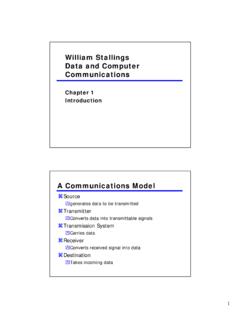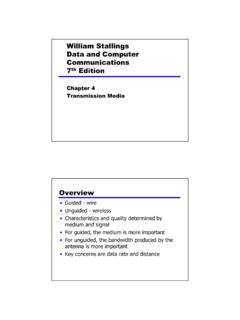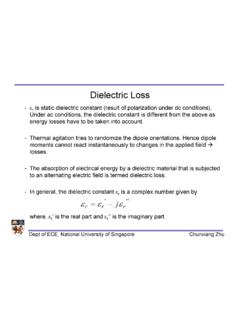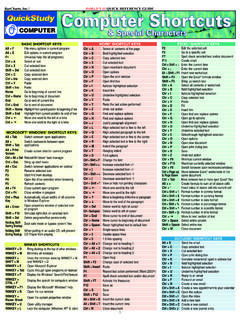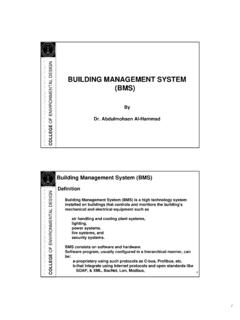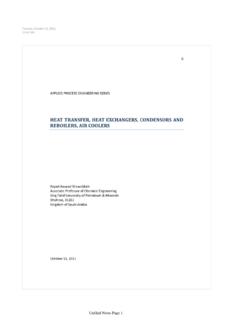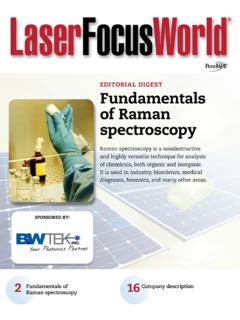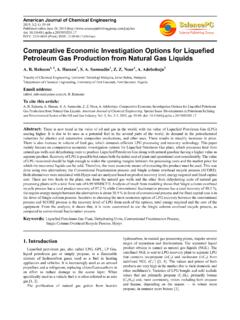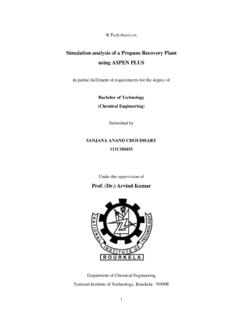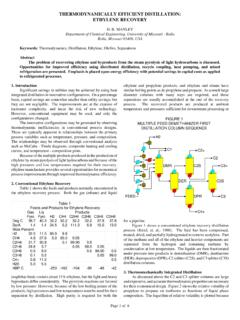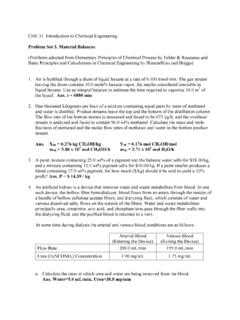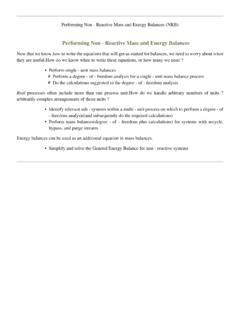Transcription of Chapter 4 MATERIAL BALANCES AND APPLICATIONS
1 Chapter 4 MATERIAL BALANCES AND APPLICATIONS 1 MATERIAL BALANCES AND APPLICATIONS Introduction MATERIAL BALANCES are important first step when designing a new process or analyzing an existing one. They are almost always prerequisite to all other calculations in the solution of process engineering problems. MATERIAL BALANCES are nothing more than the application of the law of conservation of mass, which states that mass can neither be created nor destroyed. Thus, you cannot, for example, specify an input to a reactor of one ton of naphtha and an output of two tons of gasoline or gases or anything else. One ton of total MATERIAL input will only give one ton of total output, total mass of input = total mass of output. A MATERIAL balance is an accounting for MATERIAL . Thus, MATERIAL BALANCES are often compared to the balancing of current accounts.
2 They are used in industry to calculate mass flow rates of different streams entering or leaving chemical or physical processes. The General balance Equation Suppose propane is a component of both the input and output streams of a continuous process unit shown below, these flow rates of the input and output are measured and found to be different. qin (kg propane/h) qout (kg propane/h) If there are no leaks and the measurements are correct, then the other possibilities that can account for this difference are that propane is either being generated, consumed, or accumulated within the unit. A balance (or inventory) on a MATERIAL in a system (a single process unit, a collection of units, or an entire process) may be written in the following general way: Process unit 2 Input + generation output consumption = accumulation (enters through system boundaries) (produced within system boundaries) (leaves through system boundaries) (consumed within system) (buildup within system) This general balance equation may be written for any MATERIAL that enters or leaves any process system; it can be applied to the total mass of this MATERIAL or to any molecular or atomic species involved in the process.
3 The general balance equation may be simplified according to the process at hand. For example, by definition, the accumulation term for steady-state continuous process is zero. Thus the above equation becomes: Input + generation = output + consumption For physical process, since there is no chemical reaction, the generation and consumption terms will become zero, and the balance equation for steady-state physical process will be simply reduced to: Input = Output BALANCES on single and Multiple Physical Systems Procedure for MATERIAL balance Calculations In MATERIAL balance problems, you will usually be given a description of a process, the values of several process variables, and a list of quantities to be determined. In order to be trained on using a systematic procedure to solve MATERIAL balance problems, you are advised to follow the steps summarized below: 1.
4 Draw and label the process flow chart (block diagram). When labeling, write the values of known streams and assign symbols to unknown stream variables. Use the minimum number possible of symbols. 2. Select a basis of calculation. This is usually the given stream amounts or flow rates, if no given then assume an amount of a stream with known composition. 33. Write MATERIAL balance equations. Note in here the maximum number of independent equations you can write for each system is equal the number of species in the input and output streams of this system. Also note to first write BALANCES that involve the fewest unknown variables. 4. Solve the equations derived in step 3 for the unknown quantities to be determined. Notes i. Minimize the symbols assigned to unknown quantities by utilizing all the given process specifications and using laws of physics.
5 Ii. After doing calculations on certain basis, you may scale up or scale down (convert to new basis) while keeping the process balanced. This is done by multiplying all streams (except mass or mole fractions) by the scale factor which is equal to the ratio of the new stream amount or flow rate to the old one. You can only scale between mass amount or flow rates regardless of units used but not from mass to molar quantity or flow rate. The examples below will illustrate the procedure of BALANCES on physical processes: EXAMPLE: balance on a mixing unit An aqueous solution of sodium hydroxide contains 20% NaOH by mass. It is desired to produce an 8% NaOH solution by diluting a stream of the 20% solution with a stream of pure water. 1. Calculate the ratios (g H2O/g feed solution) and (g product solution/g feed solution). 2. Determine the feed rates of 20% solution and diluting water needed to produce 2310 lbm/min of the 8% solution.
6 Solution We could take a basis of 2310 lbm product/min, but for illustrative purposes and to have neater numbers to work with let us choose a different basis and scale the final results. Basis: 100 g Feed Solution 4 Draw and label the flowchart, remembering that the amount of the product stream is now unknown. (Since the known stream amount is given in grams, it is convenient to label all unknown amounts with this unit.) There are two unknowns - Q1 and Q2 - and since there are two substances - NaOH and H2O - in the input and output streams, two BALANCES may be written to solve for them. The total mass balance and the water balance involve both unknowns, but the NaOH balance involves only one. NaOH balance ()()()( )g = =QQ It is a good practice to write calculated variable values on the flowchart as soon as they are known for ease of use in later calculations; at this point, 250 would therefore be written in place of Q2 on the chart.
7 Total Mass balance OHg150g 250g10021221===+ QQQQ 100 g g NaOH/g g H2O/g Q2 (g) g NaOH/g g H2O/g Q1 (g H2O) 5 The desired ratios can now be calculated: 100O)H(g2150211= QQ solutionfeed gproduct 100O)H(g250222= QQ The scale factor is obtained as the true flow rate of the product stream divided by the rate calculated on the assumed basis. Feed Solution Flow Rate minsolutionfeedlb924 Dilution Water Flow Rate minOHlb1386 1502mm= Check: (924 + 1386) lbm/min = 2310 lbm/min 6 EXAMPLE: Scale up of a separation process flowchart A 60 - 40 mixture (by moles) of A and B is separated into two fractions. A flowchart of the process is shown here. It is desired to achieve the same separation with a continuous feed of 1250 lb-moles/h. Scale the flowchart accordingly. Solution The scale factor is The masses of all streams in the batch process are converted to flow rates as follows: Feed: specified)(ashmoles-lb1250molmoles/h-lb Top product stream: ( )( ) = 625 lb-moles/h Bottom product stream: ( )( ) = 156 lb-moles A/h ( )( ) = 469 lb-moles B/h The units of the mole fractions in the top product stream may be changed from mol/mol to lb-mole/lb-mole, but their values remain the same.
8 The flowchart for the scaled-up process is shown here. mol mol A/mol mol B/mol mol mol A/mol mol B/mol mol A mol B 625 lb-moles/hr lb-mole A/b-mole lb-mole B/b-mole 1250 lb-moles/hr lb-mol A/lb-mole lb-mol B/lb-mole 156 lb-moles A/hr 469 lb-moles B/hr 7 EXAMPLE: MATERIAL BALANCES on a distillation column A mixture containing 45% benzene (B) and 55% toluene (T) by mass is fed to a distillation column. An overhead stream of 95 wt% B is produced, and 8% of the benzene fed to the column leaves in the bottom stream. The feed rate is 2000 kg/h. Determine the overhead flow rate and the mass flow rates of benzene and toluene in the bottom stream Solution Basis : Given Feed Rate The labeled flowchart is as follows. There are three unknowns on the chart - D, wB, and wT - and therefore three equations are needed.
9 We are entitled to write only two MATERIAL BALANCES since two species are involved in the process; the third equation must therefore come from additional given information (the amount of benzene in the bottom stream.) The latter relation is. chart)theonofplacein72(WriteB/hkg72kg/h] 00)[( )( )(kgfeed)in( = = Toluene and total mass BALANCES each involve two unknowns, D and wT, but a benzene balance involves only one, D. Benzene balance ()( )chart)theonit(Writekg/h870 = +=ww 2000 kg/h kg B/kg kg T/kg D kg/h kg B/kg kg T/kg Contains 8% of the B in the feed wB kg B/kg wT kg T/kg 8 Total Mass balance (A toluene balance could be used equally well) T/hkg1060kg/h72kg/h870 DDhkg2000 TBTB= == ++=wwww EXAMPLE: Two Unit Distillation Process A labeled flowchart of a continuous steady-state two-unit distillation process is shown below.
10 Each stream contains two components, A and B, in different proportions. Three streams whose flow rates and/or compositions are not known are labeled 1, 2 and 3. Calculate the unknown flow rates and compositions of streams 1, 2, and 3. Solution The systems about which BALANCES might be taken are shown on the following representation of the flowchart. 40 kg/h kg A/kg kg B/kg 30 kg/h kg A/kg kg B/kg 30 kg/h kg A/kg kg B/kg 100 kg/h kg A/kg kg B/kg 1 2 3 40 kg/h kg A/kg kg B/kg 30 kg/h kg A/kg kg B/kg 30 kg/h kg A/kg kg B/kg 100 kg/h kg A/kg kg B/kg Q1 (kg/h) Q2 (kg/h) x1 (kg A/kg) x2 (kg A/kg) 1- x1 (kg B/kg) 1- x2 (kg B/kg) Q3 (kg/h) x3 (kg A/kg) 1- x3 (kg B/kg) 9 The outer boundary encompasses the entire process. Two of the interior boundaries surround the individual process units, and the fourth boundary encloses a stream junction point.
